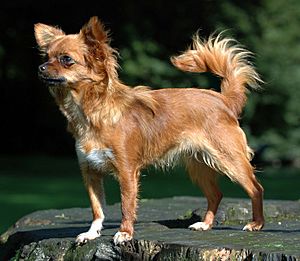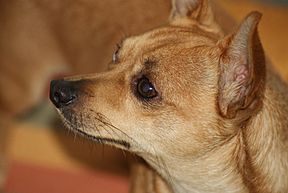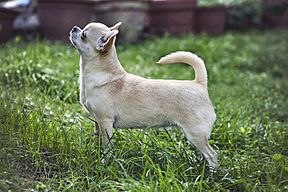Chihuahua (dog) facts for kids
 |
|||||||||||||||||||||||||
| Other names | Chihuahueño | ||||||||||||||||||||||||
|---|---|---|---|---|---|---|---|---|---|---|---|---|---|---|---|---|---|---|---|---|---|---|---|---|---|
| Origin | Mexico | ||||||||||||||||||||||||
|
|||||||||||||||||||||||||
|
|||||||||||||||||||||||||
| Domestic dog (Canis lupus familiaris) | |||||||||||||||||||||||||
The Chihuahua (pronounced Chee-WAH-wah) is a tiny dog breed from Mexico. It's named after the Mexican state of Chihuahua. These dogs are known for being one of the smallest dog breeds in the world. People usually keep them as pets or show them in dog shows. They are often called Chihuahueño in Spanish.
Contents
A Look Back: Chihuahua History
Chihuahuas have a long history, going back to ancient times in Mexico. Some scientists believe that these dogs are related to ancient dogs from North America. These older dogs arrived from Siberia about 10,000 years ago.
When Europeans first came to Mexico, they found many small dogs. In 1520, a Spanish explorer named Hernan Cortés wrote that the Aztecs kept and sold small dogs. These dogs were sometimes used for food.
The first Chihuahua was officially registered in the American Kennel Club in 1904. Its name was Midget, and it belonged to H. Raynor from Texas.
What Makes a Chihuahua Special?
Chihuahuas are the smallest dog breed recognized by many kennel clubs. They have two main head shapes: "apple-head" and "deer-head."
Head Shapes and Features
The "apple-head" Chihuahua has a large, round head. Their eyes are big and round, and their ears stand up straight. The part where their nose meets their forehead is very clear, almost like a right angle.
The "deer-head" Chihuahua has a flatter head and eyes that are set wider apart. Their ears are usually larger, and their legs are often longer and thinner. Both types can be registered, but the apple-head is usually preferred in dog shows.
Size and Weight
Chihuahuas don't have a set height in most breed standards. They usually stand between 6 and 9 inches (15 to 23 cm) tall. Some can grow taller, up to 15 inches (38 cm).
For dog shows, Chihuahuas usually weigh no more than 5.9 pounds (2.7 kg). The ideal weight is often between 4 and 6 pounds (1.8 to 2.7 kg). However, many Chihuahuas kept as pets weigh more, sometimes over 10 pounds (4.5 kg). This doesn't mean they aren't purebred. It just means they might not meet the strict rules for dog shows.
"Teacup" Chihuahuas
Some breeders try to make Chihuahuas as small as possible. These very tiny dogs are sometimes called "teacup" Chihuahuas. They can be sold for higher prices. However, breeding for extremely small size can sometimes cause health problems for the dogs.
Coat Colors and Patterns
Chihuahuas come in almost any color or color mix. They can be solid colors or have different markings.
One special coat pattern is called "merle." This pattern looks mottled or spotted. Some kennel clubs, like The Kennel Club in the UK, have decided not to register merle Chihuahuas. This is because the gene that causes the merle pattern can also be linked to certain health issues.
Temperament
Like many small dogs, Chihuahuas can sometimes be quite protective or feisty. They might bark at strangers or other dogs. This is often because they feel they need to protect themselves or their owners.
Chihuahua Health
Chihuahuas are generally healthy dogs, but like all breeds, they can have some specific health concerns. They can live for 12 years or even longer.
Common Health Concerns
Some Chihuahuas might have problems with their knees, where the kneecap can slip out of place. This is called patellar luxation. They can also be prone to dental issues, so it's important to keep their teeth clean.
In some cases, Chihuahuas can have conditions that affect their brain or spine. These are less common but can include things like fluid buildup in the brain (hydrocephalus) or certain nerve problems. Regular vet check-ups are important to keep them healthy.
See also
 In Spanish: Chihuahua (perro) para niños
In Spanish: Chihuahua (perro) para niños
- Ren Hoek from Nickelodeon's The Ren & Stimpy Show
- Beverly Hills Chihuahua



